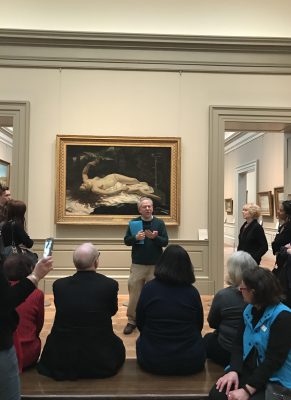The “Shady Ladies” Across the Park
The “Shady Ladies” tour was hosted by Professor Lear and featured works from artists such as Degas and Courbet. (CELESTE AZZI/THE OBSERVER)
April 11, 2017
Art, unlike any other artistic form, is able to capture and preserve the legacies of those who once were thought to be undeserving of one—what could never be written or spoken of is triumphantly extricated through art. Professor Andrew Lear’s “Shady Ladies Tour of the Met” is one that delves into the hidden meanings and slightest intricacies of the masterpieces that depict the world’s most infamous courtesans. The women are depicted at their most vulnerable, yet hold immense strength and power. From the “Oirans” of Japan to the “Hetairas” of Ancient Greece to the “Cortiganas” of the Italian Renaissance, Professor Lear covers courtesan culture– even in the most unlikely places–with a great deal of humor.
Inspired by Courbet’s “Woman with a Parrot,” Professor Lear decided to create an additional tour to the “Gay Secrets of the MET” that focused on the power of courtesans regardless of whether they were the backbone of the working class or the jewels of the French court. Its success has prompted the launch of new tours of the MET including the “Nasty Women Tour” and the “Sexy Secrets Tour.”
Surprisingly, the success of a courtesan depended the extent of her talent and wit just as much as her appearance; these were beautiful women of great intellect. Courtesans were proficient in a number of the arts, including theatre, music, art and literature. Veronica Franco was a Venetian Courtesan that published poetry, played several musical instruments and was erudite in the literature of Ancient Greece. While their education did indeed separate them from prostitutes, these were strong women that also challenged the beliefs toward women in what was a very patriarchal society.
Professor Lear tells you what the descriptions beside the artworks will never tell you. The portrait of Mrs. Grace Dalyrmple Elliott is described as “a Scottish lady of great beauty.” However, she was far more than that. After her convent education, she was married off at the age of 17 to a wealthy physician almost 20 years her senior. Her husband divorced her – in an era where a woman’s freedom, power, and well-being depended on marriage – and was thus left to fend and create a life for herself. She became the mistress of the Earl of Cholmondeley, the future King George IV, as well as the Duc d’Orléans (a leader in the French Revolution). As a woman, she was unable to hold formal political power, however her associations with those that were, facilitated indirect influence.
Just like the museum descriptions, the artworks themselves are deceptive. “The Rehearsal of the Ballet Onstage” by Edgar Degas is an oil painting of performing ballet dancers being observed by well-dressed men. Ballerinas in the 1900s, in many cases, were courtesans to the upper class men that came to watch them. “Courtesan and Two Attendants on New Year’s Day” from Japan’s Edo period illustrates a promenading women where it is only the way her obi sash was tied at the front, the many layers of garments she was wearing, and the complexity of her hair that would suggest she was a courtesan in what is modern day Tokyo.
This is a tour that celebrates the intelligence of these women; they exercised their resources in order to gain authority in a society that staunchly denied them of it. Beneath the delicate façades, are ambitious and calculative women that accomplish in the most unlikely of ways. Thus it would be an insult to look at these women and only appreciate their visible beauty, for these women were far more than that. They lived lives that were perhaps even more memorable and triumphant than the men that were in need of their companionship.
Two hours in length-and almost weekly scheduled experiences with Professor Lear himself- this tour is priced at $59 for general admission, but $35 for students and MET members. And If you find yourself in Paris this summer, be sure to experience “Shady Ladies of Paris” that is said to be even more shady than the one across the park.










